Related Research Articles
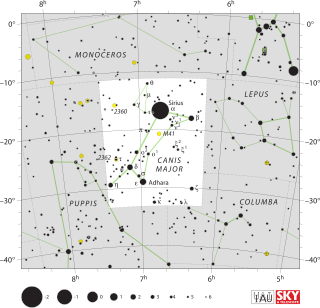
Canis Major is a constellation in the southern celestial hemisphere. In the second century, it was included in Ptolemy's 48 constellations, and is counted among the 88 modern constellations. Its name is Latin for "greater dog" in contrast to Canis Minor, the "lesser dog"; both figures are commonly represented as following the constellation of Orion the hunter through the sky. The Milky Way passes through Canis Major and several open clusters lie within its borders, most notably M41.

Eta Canis Majoris, also named Aludra, is a star in the constellation of Canis Major. Since 1943, the spectrum of this star has served as one of the stable anchor points by which other stars are classified.
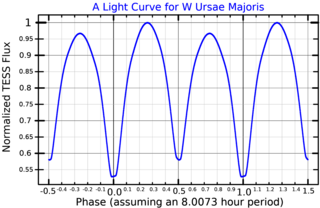
W Ursae Majoris is the variable star designation for a binary star system in the northern constellation of Ursa Major. It has an apparent visual magnitude of about 7.9, which is too faint to be seen with the naked eye. However, it can be viewed with a small telescope. Parallax measurements place it at a distance of roughly 169 light years (52 parsecs) from Earth.

Delta Velorum is a triple star system in the southern constellation of Vela, near the border with Carina, and is part of the False Cross. Based on parallax measurements, it is approximately 80.6 light-years from the Sun. It is one of the stars that at times lies near the south celestial pole due to precession.

Tau Canis Majoris is a multiple star system in the constellation Canis Major. It is approximately 5,000 light years distant from Earth and is the brightest member of the open cluster NGC 2362.

UW Canis Majoris is a star in the constellation Canis Major. It is classified as a Beta Lyrae eclipsing contact binary and given the variable star designation UW Canis Majoris. Its brightness varies from magnitude +4.84 to +5.33 with a period of 4.39 days. Bode had initially labelled it as Tau2 Canis Majoris, but this designation had been dropped by Gould and subsequent authors.
Pi1 Cygni (π1 Cygni, abbreviated Pi1 Cyg, π1 Cyg) is a binary star in the northern constellation of Cygnus. It is visible to the naked eye, having a combined apparent visual magnitude of 4.66. The distance to this system can be roughly gauged by its annual parallax shift of 1.89 mas, which yields a separation of around 1,700 light years from the Sun, give or take a hundred light years.
Pi2 Cygni, Latinized from π2 Cygni, is a triple star system in the northern constellation of Cygnus. It is visible to the naked eye about 2.5° east-northeast of the open cluster M39, having an apparent visual magnitude of 4.24. Based upon an annual parallax shift of 2.95 mas, it is located at a distance of roughly 1,100 light years from the Sun.
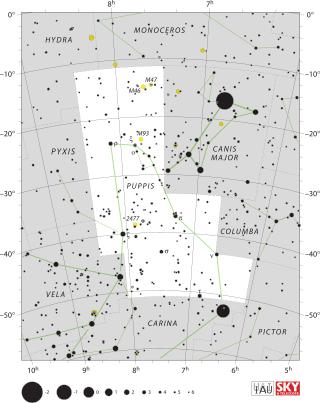
Omicron Puppis (ο Puppis) is candidate binary star system in the southern constellation of Puppis. It is visible to the naked eye, having a combined apparent visual magnitude of +4.48. Based upon an annual parallax shift of 2.30 mas as seen from Earth, it is located roughly 1,400 light years from the Sun.
57 Cygni is a close binary star system in the constellation Cygnus, located about 530 light years from Earth. It is visible to the naked eye as a blue-white hued star with a baseline apparent visual magnitude of 4.80. The pair have a magnitude difference of 0.34. This system is moving closer to the Earth with a heliocentric radial velocity of −21 km/s.

W Crucis is a single-lined eclipsing variable star system in the constellation Crux. It has a spectral class of F8/G1Ia/abe indicating a yellow supergiant with emission lines in its spectrum.

V1191 Cygni is the variable star designation for an overcontact binary star system in the constellation Cygnus. First found to be variable in 1965, it is a W Ursae Majoris variable with a maximum apparent magnitude 10.82. It drops by 0.33 magnitudes during primary eclipses with a period of 0.3134 days, while dropping by 0.29 magnitudes during secondary eclipses. The primary star, which is also the cooler star, appears to have a spectral type of F6V, while the secondary is slightly cooler with a spectral type of G5V. With a mass of 1.29 solar masses and a luminosity of 2.71 solar luminosities, it is slightly more massive and luminous than the sun, while the secondary is only around 1/10 as massive and less than half as luminous. With a separation of 2.20 solar radii, the mass transfer of about 2×10−7 solar masses per year from the secondary to the primary is one of the highest known for a system of its type.
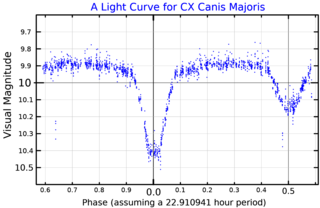
CX CMa is a blue variable star in the Canis Major constellation. Discovery of this variable is usually credited to German Astronomer Cuno Hoffmeister in 1931, although this remains uncertain.

TX Ursae Majoris is an eclipsing binary star system in the northern circumpolar constellation of Ursa Major. With a combined apparent visual magnitude of 6.97, the system is too faint to be readily viewed with the naked eye. The pair orbit each other with a period of 3.063 days in a circular orbit, with their orbital plane aligned close to the line of sight from the Earth. During the primary eclipse, the net brightness decreases by 1.74 magnitudes, while the secondary eclipse results in a drop of just 0.07 magnitude. TX UMa is located at a distance of approximately 780 light years from the Sun based on parallax measurements, but is drifting closer with a mean radial velocity of −13 km/s.

XY Ursae Majoris is a short period binary star system in the northern circumpolar constellation of Ursa Major. It is an eclipsing binary with a baseline apparent visual magnitude of 9.50. The system is located at a distance of 221.5 light years from the Sun based on parallax measurements, but is drifting closer with a radial velocity of −10 km/s. It has a relatively high proper motion, traversing the celestial sphere at the angular rate of 0.191″·yr−1.

Daniel Joseph Kelly O'Connell was a seismologist, astronomer and Jesuit priest who is particularly known for his work in observational astronomy. He worked primarily observing binary star systems, and was involved in photographing the Green Flash. He was also the third president of the Pontifical Academy of Sciences.
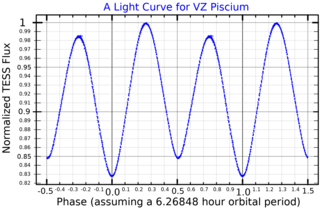
VZ Piscium is a binary star system in the equatorial constellation of Pisces. it is located at a distance of 178 light years from the Sun based on parallax measurements, and has an apparent visual magnitude of about 10.3. This is an eclipsing binary system that undergoes shallow eclipses; the brightness decreases to magnitude 10.45 during the primary eclipse, then to magnitude 10.43 with the secondary eclipse, although as a contact binary the brightness varies continuously with no period of constant maximum brightness. The system is drifting closer with a radial velocity of approximately −4 km/s, and has a net heliocentric velocity of 144.1 km/s.

VV Ursae Majoris is a binary star system in the northern circumpolar constellation of Ursa Major, abbreviated VV UMa. It is a variable star system with a brightness that cycles around an apparent visual magnitude of 10.19, making it too faint to be visible to the naked eye. The system is located at a distance of approximately 1,500 light years based on parallax measurements.

AW Ursae Majoris is a binary star system in the northern circumpolar constellation of Ursa Major, abbreviated AW UMa. It is an A-type W Ursae Majoris variable with an apparent visual magnitude of 6.83, which is near the lower limit of visibility to the naked eye. This is an eclipsing binary with the brightness dropping to magnitude 7.13 during the primary eclipse and to 7.08 with the secondary eclipse. Parallax measurements give a distance estimate of 221 light years from the Sun. It is drifting closer to the Sun with a radial velocity of approximately −17 km/s. The system has a high proper motion, traversing the celestial sphere at the rate of 0.216 arc second per annum.

RT Persei is a variable star system in the northern constellation of Perseus, abbreviated RT Per. It is an eclipsing binary system with an orbital period of 0.84940032 d (20.386 h). At peak brightness the system has an apparent visual magnitude of 10.46, which is too faint to be viewed with the naked eye. During the eclipse of the primary this decreases to magnitude 11.74, then to magnitude 10.67 with the secondary eclipse. The distance to this system is approximately 628 light years based on parallax measurements. It is drifting closer with a heliocentric radial velocity of about −12 km/s.
References
- 1 2 Milone, Eugene Frank (1968). "The Peculiar Binary RT Lacertae". Astronomical Journal. 73 (8): 708. Bibcode:1968AJ.....73..708M. doi:10.1086/110682.
- 1 2 O'Connell, D. J. K. (1951). "The so-called periastron effect in close eclipsing binaries". Riverview College Observatory Publications. 2 (6): 85. Bibcode:1951PRCO....2...85O.
- ↑ Liu, Qing-Yao; Yang, Yu-Lan (2003). "A Possible Explanation of the O'Connell Effect in Close Binary Stars". Chinese Journal of Astronomy & Astrophysics. 3 (2): 142. Bibcode:2003ChJAA...3..142L. doi:10.1088/1009-9271/3/2/142.
- ↑ Davidge, T. J.; Milone, E. F. (1984). "A study of the O'Connell effect in the light curves of eclipsing binaries". Astrophysical Journal Supplement Series. 55: 571. Bibcode:1984ApJS...55..571D. doi:10.1086/190969.
- ↑ Wilsey, Nicholas J.; Beaky, Mathew M. (2009). "Revisitng the O'Connell Effect in Eclipsing Binary Systems". 28th Annual Symposium on Telescope Science. Held May 19–21, 2009 at Big Bear Lake, CA. Society for Astronomical Sciences. 28: 107. Bibcode:2009SASS...28..107W.
- ↑ Milone, E. F. (1986). "The O'Connell effect systems CX Canis Majoris, TU Crucis, AQ Monocerotis, and DQ Velorum". Astrophysical Journal Supplement Series. 61: 455. Bibcode:1986ApJS...61..455M. doi:10.1086/191119.
- ↑ Zeilik, M.; Gordon, S.; Jaderlund, E.; Ledlow, M.; Summers, D. L.; Heckert, P. A.; Budding, E.; Banks, T. S. (1979). "The changing light curves of CG Cygni". Astronomical Journal. 84: 417. Bibcode:1994ApJ...421..303Z. doi:10.1086/173647.